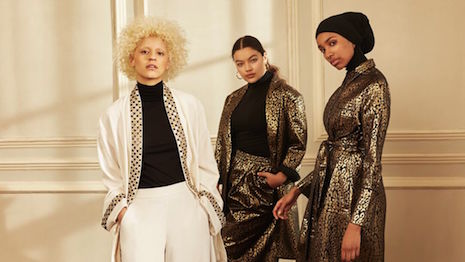- About
- Subscribe Now
- New York,
November 6, 2018

 Layeur by The Modist is the platform's new private label. Image credit: the Modist
Layeur by The Modist is the platform's new private label. Image credit: the Modist
In 2017, Muslim clientele spent $2.1 trillion on products and services such as modest fashion, travel and halal cosmetics, pointing to potential for luxury brands that cater to their needs and values.
According to a report from Thompson Reuters, the Islamic economy is poised to reach $3 trillion by 2023. A number of international and mainstream luxury companies have already sought this market through Muslim-friendly merchandise and experiences, but the outlook shows more room for growth.
"There is substantial premium opportunity across core sectors impacted by the ethical values of Muslims, in particular in cosmetics and modest, given Muslims spent $331 billion on apparel and personal care combined in 2017, a figure that will grow at 6 percent CAGR to reach $451 billion by 2023," said Haroon Latif, director of strategic insights at DinarStandard and lead author of the report.
"While the opportunity is global, regional clusters exist, most notably in the GCC, where per capita incomes are among the highest in the world, and Indonesia, which represents 10 percent of global Muslim spend across the core sectors of the halal economy opportunity," he said.
Islamic opportunity
Per the report, Malaysia and the United Arab Emirates are the nations best positioned to take advantage of the growing Islamic economy. Among their efforts has been the development of product manufacturing with religiously acceptable halal practices.
While Malaysia tops the rankings, the U.A.E. leads in creating fashion and travel experiences for the Muslim world.
Muslim spend on hospitality is currently at $177 billion, and is projected to reach $274 billion in the next five years. While most of the outbound tourism spend is in the Middle East and Africa, some of the other top destinations include East and Central Asia and Western Europe.
When traveling, amenities such as halal-friendly food options, separate prayer rooms and segregated swimming pools enable Muslim guests to respect their religious practices even while away.
Jumeirah Vittaveli beach villa. Image credit: Jumeirah
Turkey, for instance, has created a halal accreditation authority, allowing travelers to book with peace of mind.
Muslim travelers are highly interested in family-friendly beach getaways, but they are also showing a preference for cultural and religious tourism.
Aside from outbound tourism, a number of Middle Eastern countries are looking to lure more travelers.
For instance, while Saudi Arabia has been open to business travel and religious pilgrimages, visiting for pleasure had never been an option. But now the Middle Eastern destination will be opened up to tourists through a new visa that extends to leisure travelers, likely attracting affluents who seek out unique spots and true cultural experiences (see story).
Along with travel, spending on modest fashion is rising. Totaling $270 billion last year, the category is set to grow at a CAGR of 5 percent to reach $361 billion by 2023.
More mainstream brands are adopting modest styles. The report notes that while labels may have previously only created covered looks for special occasions such as Ramadan, today brands are more apt to have year-round offerings.
Dolce & Gabbana created an abaya collection. Image credit: Dolce & Gabbana
Hijabi model Halima Aden has been cast in runway shows and campaigns for brands including Max Mara and Dolce & Gabbana.
Fashion retailer Net-A-Porter has also sought to give Muslim customers an easier way to browse by launching a “modest” tab of edited pieces.
In addition to fashion, Muslims are driving a 6.9 percent CAGR in halal cosmetics, which are made without pork ingredients or alcohol. This market is set to reach $90 billion by 2023.
"The core to addressing the opportunity is to do the necessary market research, because oftentimes, the market opportunity and strategic options are not abundantly obvious," Mr. Latif said. "Once a strong strategic case is made and approved, the next step is a rigorous market assessment engaging directly with target consumers."
Regional outreach
Media is also appealing to the Muslim world. Condé Nast’s GQ brand recently brought its take on fashion to the Arabian Gulf with the premiere issue of its Middle East edition.
GQ Middle East, which hit newsstands on Oct. 4 alongside a new Web site, is a bilingual publication aimed at the regional audience. This marks GQ’s 21st international title around the globe, allowing the brand to expand its influence among fashion-forward men (see story).
As brands look to break in to the Middle East in particular, they need to be aware of cultural and behavioral differences.
Whereas the ecommerce market is built up in markets such as the United States and China, the Middle East still represents a largely untapped online market ripe with opportunity for luxury brands.
With a wealthy population that is heavily connected via the Internet and smartphones, the foundation is set for luxury ecommerce in the region, but online retail in the Gulf States remains in its infancy. In a keynote at Luxury Interactive on Oct. 15, an executive from Al Tayer Group laid out both the challenges and solutions for tapping into the region via digital channels (see story).
"The engagement needs to account for the fact that Muslims are predominantly young, with an average of 24 versus 32 for the global average," Mr. Latif said. "Muslims are very active and engaged online, so social media is a necessary part of engagement, not just to launch a product, but to continuously iterate.
"That approach has worked especially well for digitally-native and Muslim-native brands, most notably success stories such as Wahed Invest, Muzmatch and Modanisa, among many other examples," he said.
Share your thoughts. Click here